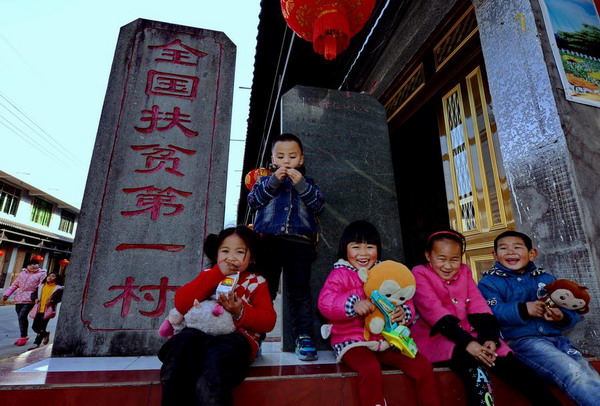
Children of Se ethnic group sit in front of a monument that reads "China's No. 1 Poverty Relief Village" at Chixi Village, Panxi town, Fuding city in East China's Fujian province, Feb 14. The village has shaken off poverty thanks to assistance from Party and government officials at all levels over the past 30 years. (Photo/Xinhua)
Targeted poverty relief is very important for China to meet the poverty alleviation target set out in the Rural Poverty Relief and Development Outline (2011-20). To achieve that goal, we have to change our concepts of poverty relief and development, reform management system and poverty alleviation. That is also important to improve the working mechanism of targeted poverty relief.
First, some local authorities misunderstand the meaning of targeted poverty relief. They assume the policy is aimed at helping the targeted group increase its income in the short term, or directly allocating poverty alleviation funds to the impoverished group.
In fact, targeted poverty relief means comprehensive, scientific, high-quality, highly efficient and continuous poverty alleviation. The poverty relief targets stated in the outline have to be achieved in an all-round way-the authorities have to plan and implement poverty relief measures according to the principle of poverty alleviation, implement high-quality poverty relief development projects and intervention measures, as well as improve the lot of the targeted impoverished group.
Second, poverty relief management systems and policies that are not suited to meet the demands of targeted poverty relief should be changed. Establishing a set of precise poverty relief management systems and policies that are very efficient, coordinated, and guarantee equal rights and responsibilities is essential for achieving poverty relief targets. The authorities have to strictly implement the management systems of poverty alleviation: central authorities should devise the overall plans, and provincial authorities should take the full responsibility of implementing them with local authorities helping them meet the poverty alleviation targets.
Top leaders of local Party committees and local governments are in charge of poverty alleviation and development work. Pilot projects should be introduced in key impoverished counties to reduce special transfer payments and increase general transfer payments. Plus, local authorities should be granted more power in policymaking, implementation and management of poverty relief.
Third, the authorities have to deal with the complications that emerge during the implementation of targeted poverty relief programs. Steadily increasing low-income families' earnings is the key, but difficult-to-achieve, factor in poverty alleviation work.
To help build a moderately well-off society, the authorities at all levels should pay equal attention to the impoverished groups' housing, potable water, transportation, education, medical care and social security demands during the process of targeted poverty relief.
The authorities should also expedite the process of poverty alleviation and pay attention to the quality of service they render. If officials are unable to increase the funds for poverty relief or achieve a breakthrough in institutional innovation in a short time, they should strike the right balance between the quantity and quality of poverty relief and development work.
Since the government leads the poverty relief and development strategy in China, it will also play a dominant role in targeted poverty relief programs and the fundamental role in poverty alleviation planning, resource allocation, implementation and management. But it is also important to ensure that low-income families and poor communities play their respective roles in the entire process.
Giving every impoverished household access to poverty relief programs is the intrinsic requirement of targeted poverty relief. But it doesn't signify directly distributing poverty relief resources to every impoverished family. Given the actual situation in impoverished areas and condition of families, in some cases the desired effects of poverty relief may not be achieved if we directly hand the resources to them.
For instance, the direct distribution of resources among impoverished families in areas with high numbers of poor households could lead to waste of resources and the failure of poverty relief projects if local development is not improved.


















































